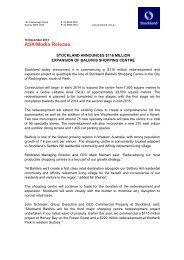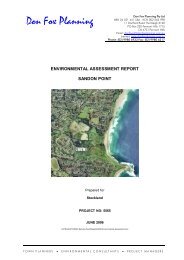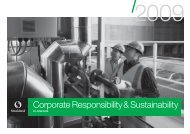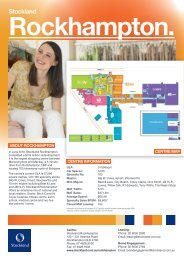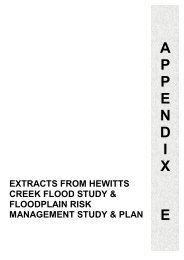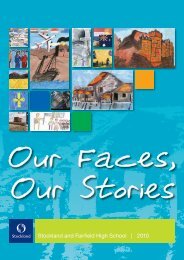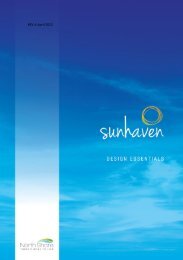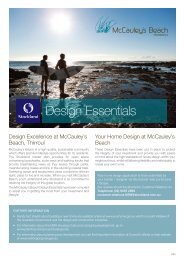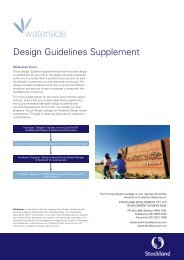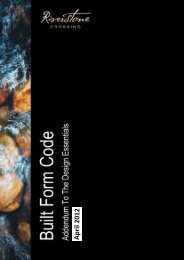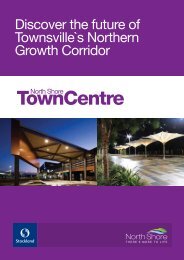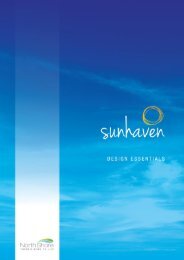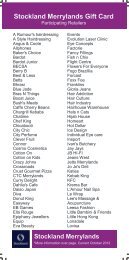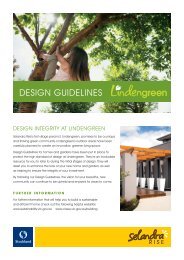SDOT2 Financial Report 30 June 2008 - Stockland
SDOT2 Financial Report 30 June 2008 - Stockland
SDOT2 Financial Report 30 June 2008 - Stockland
You also want an ePaper? Increase the reach of your titles
YUMPU automatically turns print PDFs into web optimized ePapers that Google loves.
2007<br />
<strong>Stockland</strong> Direct<br />
Office Trust No.2<br />
Annual <strong>Report</strong><br />
<strong>30</strong> <strong>June</strong> 2007
<strong>Stockland</strong> Direct<br />
Office Trust No.2—<br />
Contents<br />
Directors’ <strong>Report</strong> 1<br />
Lead Auditor’s<br />
Independence Declaration 4<br />
Income Statement 5<br />
Balance Sheet 6<br />
Statement of Changes<br />
in Equity 7<br />
Cash Flow Statement 8<br />
Notes to the <strong>Financial</strong><br />
Statements 9<br />
Directors’ Declaration 23<br />
Independent Audit <strong>Report</strong> 24
Directors’ report—<br />
—for the year ended <strong>30</strong> <strong>June</strong> 2007<br />
The Directors of <strong>Stockland</strong> Funds<br />
Management Limited (“SFML”), the<br />
Responsible Entity of <strong>Stockland</strong> Direct<br />
Office Trust No. 2 (the “Trust”), present<br />
their report together with the <strong>Financial</strong><br />
<strong>Report</strong> made in accordance with a<br />
resolution of the Directors with respect to<br />
the results of the Trust for the year ended<br />
<strong>30</strong> <strong>June</strong> 2007, the state of the Trust’s<br />
affairs as at <strong>30</strong> <strong>June</strong> 2007 and the related<br />
Independent Auditor’s <strong>Report</strong>.<br />
Directors<br />
The Directors of the Responsible Entity at<br />
any time during or since the end of the<br />
financial year (“the Directors”) are:<br />
Peter Scott<br />
Chairman (Non-Executive)<br />
Appointed 22 November 2005<br />
Mr Scott is a director of <strong>Stockland</strong><br />
Corporation Limited (“<strong>Stockland</strong>”), Sinclair<br />
Knight Merz Holdings Limited and<br />
Perpetual Limited. Mr Scott is also a<br />
Director of Pilotlight, a non-profit making<br />
organisation, is an employee of Korn Ferry<br />
International Pty Ltd and is on the Advisory<br />
Board of Jones Lang LaSalle Australia. Mr<br />
Scott was the Chief Executive Officer of<br />
MLC and Executive General Manager,<br />
Wealth Management of National Australia<br />
Bank until January 2005. Prior to this, he<br />
held a number of senior positions with<br />
Lend Lease, following a successful career<br />
as a consulting engineer in Australia and<br />
overseas. Mr Scott was appointed as a<br />
Director and was elected Chairman of<br />
<strong>Stockland</strong> Funds Management Limited on<br />
22 November 2005.<br />
Lyn Gearing<br />
(Non-Executive)<br />
Appointed 22 November 2005<br />
Ms Gearing is currently a director of<br />
<strong>Stockland</strong>, Hancock Natural Resource<br />
Group Australasia Pty Limited, IMB<br />
Limited and the Garvan Research<br />
Foundation. Ms Gearing was Chief<br />
Executive of NSW State Super from 1997<br />
to 2002, and has extensive business<br />
experience in superannuation, funds<br />
management, corporate finance and<br />
management consulting. Ms Gearing was<br />
appointed Chair of the <strong>Stockland</strong> Trust<br />
Management Limited and <strong>Stockland</strong> Funds<br />
Management Limited Compliance<br />
Committees on 1 July 2006. She is also a<br />
member of both the <strong>Stockland</strong> and<br />
<strong>Stockland</strong> Funds Management Limited<br />
Audit and Risk Committees.<br />
David Kent<br />
(Non-Executive) - Independent<br />
Appointed 9 August 2004<br />
Mr Kent is Executive Chairman of Everest<br />
Babcock and Brown Limited and a director<br />
of the Australian chapter of the Alternative<br />
Investment Management Association<br />
(“AIMA”). He was previously Executive<br />
General Manager of Axiss Australia and<br />
served as a member of the <strong>Financial</strong><br />
Sector Advisory Council. Mr Kent is a past<br />
Senior Trade and Investment<br />
Commissioner in Paris and Washington DC<br />
for the Australian Trade Commission. Mr<br />
Kent formerly worked for Morgan Stanley<br />
in Sydney, Melbourne and New York<br />
where he became Managing Director and<br />
Head of Investment Banking. Mr Kent has<br />
previously served as Deputy Chairman of<br />
the Art Gallery of NSW Foundation,<br />
Chairman of the Brett Whiteley Foundation<br />
and is currently on the S.H. Ervin Gallery<br />
Committee.<br />
Tony Sherlock<br />
(Non-Executive) - Independent<br />
Appointed 9 August 2004<br />
Mr Sherlock is a former Senior Partner of<br />
Coopers & Lybrand having national<br />
responsibility for credit risk management.<br />
In that capacity, he has obtained<br />
experience in the banking and finance,<br />
mining, agriculture, building, construction<br />
and development sectors. Mr Sherlock is a<br />
non-executive director of Sydney<br />
Attractions Group Limited, IBA Health<br />
Limited, Export Finance Insurance<br />
Corporation and Equatorial Mining Limited.<br />
He is a consultant to the Chairman of the<br />
Audit Committee of Commander<br />
Communications Limited. Mr Sherlock is<br />
the former Chairman of the Woolmark<br />
Company and has acted on a number of<br />
committees for both Federal and State<br />
governments. He is a member of the<br />
<strong>Stockland</strong> Funds Management Limited<br />
Compliance Committee. He is also a<br />
member of the <strong>Stockland</strong> Funds<br />
Management Limited Audit and Risk<br />
Committee.<br />
// 1<br />
<strong>Stockland</strong> Direct Office Trust No.2 <strong>June</strong> 2007
Directors’ <strong>Report</strong> (continued)<br />
For the year ended <strong>30</strong> <strong>June</strong> 2007<br />
2 //<br />
Directors (continued)<br />
Terry Williamson<br />
(Non-Executive)<br />
Appointed 2 July 2004<br />
Mr Williamson is a director of <strong>Stockland</strong>,<br />
Avant Insurance Limited and ING Australia<br />
Limited and a member of the University of<br />
Sydney Faculty of Economics and Business<br />
Studies Advisory Board. Mr Williamson was<br />
previously Chief <strong>Financial</strong> Officer of Bankers<br />
Trust Australia Limited / BT <strong>Financial</strong> Group<br />
Pty Limited from 1997 to 2002 and prior to<br />
that, he was a partner of Price Waterhouse<br />
for 17 years. He is a member of both the<br />
<strong>Stockland</strong> Trust Management Limited and<br />
<strong>Stockland</strong> Funds Management Limited<br />
Compliance Committee. Mr Williamson is<br />
Chair of the <strong>Stockland</strong> and <strong>Stockland</strong> Funds<br />
Management Limited Audit and Risk<br />
Committees.<br />
Matthew Quinn<br />
(Executive) – Managing Director -<br />
<strong>Stockland</strong><br />
Appointed 19 October 2000<br />
Mr Quinn has an extensive background in<br />
commercial, retail, industrial and residential<br />
property investment and development. He<br />
began his career in the United Kingdom as a<br />
chartered accountant and moved to Australia<br />
in 1987 with Price Waterhouse. In 1988, he<br />
joined the Rockingham Park Group, a<br />
substantial Western Australian private<br />
property group. Mr Quinn joined <strong>Stockland</strong><br />
in 1999 and was appointed to his current role<br />
of Managing Director in October 2000. Mr<br />
Quinn held the position of National President<br />
of the Property Council of Australia from<br />
March 2003 until March 2005. He is a<br />
Fellow of the Australian Property Institute.<br />
He was appointed Director of Australian<br />
Business and Community Network Limited<br />
in October 2006.<br />
SFML Compliance Committee<br />
A Compliance Committee has been set up<br />
to oversee the Compliance Plan approved<br />
by the Responsible Entity for the Trust.<br />
The members of the Compliance<br />
Committee during or since the end of the<br />
financial period were:<br />
Ms. L. Gearing (Chair) –<br />
Non-Executive Director<br />
Mr. A. Sherlock –<br />
Independent Non-Executive Director<br />
Mr. T. Williamson –<br />
Non-Executive Director<br />
The role of the committee includes<br />
evaluation of the effectiveness of the<br />
Responsible Entity’s compliance systems<br />
designed to protect the interests of<br />
unitholders. The Compliance Plan has been<br />
approved by ASIC. The committee meets<br />
regularly and must report breaches of the<br />
law and Constitution to the SFML Board<br />
which is required to report any material<br />
breach of the Compliance Plan to ASIC.<br />
SFML Audit and Risk Committee<br />
The Audit and Risk Committee has been set<br />
up to make appropriate recommendations<br />
to the Board and to determine any matters<br />
delegated to it by the Board, either<br />
specifically or under its charter.<br />
The primary objective of the committee is<br />
to assist the Board of SFML in discharging<br />
its responsibilities for:<br />
• financial reporting and audit practices;<br />
• accounting policies;<br />
• the management of risk; and<br />
• the adequacy and effectiveness of<br />
internal controls.<br />
Audit and Risk Committee meetings are to<br />
be held at least quarterly and guests are<br />
invited to attend such as executive<br />
management staff, external and internal<br />
auditors and advisors. The committee<br />
meets privately with the external auditor in<br />
the absence of management at least once<br />
a year. The committee has the power to<br />
conduct or authorise investigations into, or<br />
consult independent specialists on, any<br />
matters within the committee’s scope of<br />
responsibility. The committee has a<br />
written charter which incorporates best<br />
practice.<br />
Under its charter, the committee must be<br />
comprised of at least three or more<br />
directors, all of whom must be nonexecutive<br />
directors. The Chairman of the<br />
committee may not also be the Chairman<br />
of the SFML Board.<br />
The members of the Audit and Risk<br />
Committee during or since the end of the<br />
financial period were:<br />
Mr T Williamson (Chair) –<br />
Non-Executive Director<br />
Mr A Sherlock –<br />
Independent Non-Executive Director<br />
Ms L Gearing –<br />
Non-Executive Director<br />
The committee assists the Board to fulfil<br />
its corporate governance and disclosure<br />
responsibilities in relation to financial<br />
reporting, internal controls, risk<br />
management systems and both internal<br />
and external audits.<br />
Principal activities<br />
The principal activity of the Trust is the<br />
ownership of property situated at 1-5 Lyon<br />
Park Road, Macquarie Park, New South<br />
Wales via its investment of 49% in<br />
Macquarie Park Trust (“MPT”).<br />
Review of operations<br />
The Trust achieved a profit from operating<br />
activities of $29,025,000 for the financial<br />
year ended <strong>30</strong> <strong>June</strong> 2007 (<strong>30</strong> <strong>June</strong> 2006:<br />
$1,150,000).<br />
An upwards revaluation totalling<br />
$28,599,000 was recognised in the Trust’s<br />
Income Statement through the recognition<br />
of the Trust’s share of net profits of the joint<br />
venture. During the year an independent<br />
valuation was performed with the result of<br />
the Macquarie Park Property being revalued<br />
at $410,000,000 (100% basis).<br />
Distributions paid or declared by the Trust to<br />
unitholders during the financial year are set<br />
out in Note 18 of the <strong>Financial</strong> Statements.<br />
On 15 <strong>June</strong> 2007, the Trust acquired a<br />
49% interest in MPT.<br />
Significant changes in the state of affairs<br />
Apart from the matters discussed in the<br />
Review of operations, there have been no<br />
significant changes in the state of the<br />
affairs of the Trust during the year.<br />
<strong>Stockland</strong> Direct Office Trust No.2 <strong>June</strong> 2007
Directors’ <strong>Report</strong> (continued)<br />
For the year ended <strong>30</strong> <strong>June</strong> 2007<br />
Events subsequent to the end of the year<br />
There have been no events subsequent to<br />
the balance date which would have a<br />
material effect on the Trust’s <strong>Financial</strong><br />
Statements at <strong>30</strong> <strong>June</strong> 2007.<br />
Likely developments<br />
The Trust will continue to review<br />
investment strategies with a view to<br />
optimising both the income and capital<br />
return over the investment term.<br />
Environmental regulation<br />
The Trust’s operations are subject to<br />
various environmental regulation under<br />
both Commonwealth and State legislation.<br />
The Responsible Entity believes that the<br />
Trust has adequate systems in place for<br />
the management of its environmental<br />
responsibilities and is not aware of any<br />
breach of environmental requirements as<br />
they may apply to the Trust.<br />
Related parties<br />
<strong>Stockland</strong> Trust Management Limited as<br />
Responsible Entity of <strong>Stockland</strong> Trust, a<br />
related party of the Responsible Entity, holds<br />
5,247,050 instalment receipts as at <strong>30</strong> <strong>June</strong><br />
2007 (2006: 5,247,050 instalment receipts).<br />
Interests of the Responsible Entity<br />
The Responsible Entity has not held any<br />
units in the Trust either directly or indirectly<br />
during the financial year.<br />
a portion of the annual fees each year. The<br />
Responsible Entity is entitled to recover all<br />
fees deferred either from Trust earnings or<br />
on wind up of the Trust. The Responsible<br />
Entity charges are set out in Note 21 of the<br />
<strong>Financial</strong> <strong>Report</strong>.<br />
Directors’ interests<br />
The relevant interest of each director of the<br />
Responsible Entity holding instalment<br />
receipts in the Trust at the date of this<br />
report is as follows:<br />
Director<br />
Number of instalment<br />
receipts held<br />
Mr David Kent 425,000<br />
Mr Matthew Quinn 25,000<br />
Mr Peter Scott 25,000<br />
Mr Terry Williamson 100,000<br />
Indemnities and insurance of officers and<br />
auditors<br />
Indemnification<br />
Under the Trust Constitution, the<br />
Responsible Entity, including its officers and<br />
employees, is indemnified out of the Trust’s<br />
assets for any loss, damage, expense or<br />
other liability incurred by it in properly<br />
performing or exercising any of its powers,<br />
duties or rights in relation to the Trust.<br />
The Trust has not indemnified or made a<br />
relevant agreement for indemnifying<br />
against a liability in respect of any person<br />
who is the auditor of the Trust.<br />
against certain liabilities (subject to<br />
specified exclusions) for persons who are<br />
or have been directors and officers of the<br />
Responsible Entity.<br />
In addition, the Responsible Entity has paid<br />
insurance premiums for professional<br />
indemnity insurance policies to cover<br />
certain risks for the Directors.<br />
Details of the nature and the amount of the<br />
liabilities covered or the amount of the<br />
premium paid has not been included as<br />
such disclosure is prohibited under the<br />
terms of the insurance contracts.<br />
Lead Auditor’s Independence Declaration<br />
under Section <strong>30</strong>7C of the Corporations<br />
Act 2001<br />
The external auditor’s independence<br />
declaration is set out on page 4 and forms<br />
part of the Directors’ <strong>Report</strong> for the year<br />
ended <strong>30</strong> <strong>June</strong> 2007.<br />
Rounding<br />
The Trust is an entity of the kind referred to<br />
in ASIC Class Order 98/100 (as amended)<br />
and in accordance with that Class Order,<br />
amounts in the <strong>Financial</strong> <strong>Report</strong> and<br />
Directors’ <strong>Report</strong> have been rounded to<br />
the nearest thousand dollars, unless<br />
otherwise stated.<br />
Signed in accordance with a resolution of<br />
the Directors:<br />
// 3<br />
Responsible Entity’s remuneration<br />
The Responsible Entity charged a<br />
responsible entity fee of 0.45% p.a. of the<br />
gross assets of the Trust, calculated<br />
monthly. The Responsible Entity may defer<br />
Insurance premiums<br />
The Responsible Entity has paid insurance<br />
premiums in respect of directors’ and<br />
officers’ liability insurance contracts for the<br />
Directors. Such insurance contracts insure<br />
Matthew Quinn<br />
Director<br />
Dated at Sydney, 16 August 2007<br />
<strong>Stockland</strong> Direct Office Trust No.2 <strong>June</strong> 2007
Lead Auditor’s<br />
independence<br />
declaration<br />
under Section <strong>30</strong>7C of the Corporations<br />
Act 2001<br />
To: the directors of the Responsible Entity of <strong>Stockland</strong> Direct Office Trust No. 2, <strong>Stockland</strong> Funds Management Limited.<br />
I declare that, to the best of my knowledge and belief, in relation to the audit for the financial year ended <strong>30</strong> <strong>June</strong> 2007 there have been:<br />
(i) no contraventions of the auditor independence requirements as set out in the Corporations Act 2001 in relation to the audit; and<br />
(ii) no contraventions of any applicable code of professional conduct in relation to the audit.<br />
KPMG<br />
Scott Fleming<br />
Partner<br />
Sydney<br />
16 August 2007<br />
4 //<br />
<strong>Stockland</strong> Direct Office Trust No.2 <strong>June</strong> 2007
2007 2006<br />
Notes $’000 $’000<br />
Revenue and other income<br />
Interest income 4 2,437 1,924<br />
Share of profit of investments accounted for using the equity method 9 29,161 -<br />
Realised gain on financial instruments 540 -<br />
Other revenue 42 -<br />
Total revenue and other income 32,180 1,924<br />
Finance costs to external parties 1 (1,212) (545)<br />
Auditors’ remuneration 5 (52) (42)<br />
Responsible Entity fees 21 (221) (121)<br />
Performance fee (1,589) -<br />
Other expenses (81) (66)<br />
Total expenses before finance costs to unitholders (3,155) (774)<br />
Profit from operating activities 29,025 1,150<br />
Distribution (finance) expense to unitholders 1 18 (4,062) (2,164)<br />
Change in net assets attributable to unitholders 17 24,963 (1,014)<br />
1 Total finance costs for the Trust are $5,274,000 (2006: $2,709,000), being the sum of finance costs to external parties and distributions to unitholders. In order to comply with AASB 132, the unitholders’ funds are required to<br />
be treated as a liability to unitholders and trust distributions to be treated as an expense in the Income Statement.<br />
The above Income Statement should be read in conjunction with the accompanying notes.<br />
Income<br />
statement<br />
For the year ended <strong>30</strong> <strong>June</strong> 2007<br />
// 5<br />
<strong>Stockland</strong> Direct Office Trust No.2 <strong>June</strong> 2007
Balance<br />
sheet<br />
As at <strong>30</strong> <strong>June</strong> 2007<br />
6 //<br />
2007 2006<br />
Notes $’000 $’000<br />
Current assets<br />
Cash and cash equivalents 6 2,815 8,154<br />
Trade and other receivables 7 48 -<br />
Other assets 8 234 5<br />
Total current assets 3,097 8,159<br />
Non-current assets<br />
Investments accounted for using the equity method 9 202,373 -<br />
Trade and other receivables 10 - 25,893<br />
Other assets 11 6,793 2,687<br />
Total non-current assets 209,166 28,580<br />
Total assets 212,263 36,739<br />
Current liabilities<br />
Trade and other payables 12 1,371 657<br />
Total current liabilities 1,371 657<br />
Non-current liabilities<br />
Interest-bearing loans and borrowings 13 99,369 5,384<br />
Provisions 14 1,589 -<br />
Other payables 15 - 192<br />
Total non-current liabilities 100,958 5,576<br />
Total liabilities (excluding net assets attributable to unitholders) 102,329 6,233<br />
Net assets attributable to unitholders 17 109,934 <strong>30</strong>,506<br />
The above Balance Sheet should be read in conjunction with the accompanying notes.<br />
<strong>Stockland</strong> Direct Office Trust No.2 <strong>June</strong> 2007
Unitholders’ Funds<br />
Units on Issue Undistributed Income Total<br />
<strong>30</strong> <strong>June</strong> 2007 <strong>30</strong> <strong>June</strong> 2006 <strong>30</strong> <strong>June</strong> 2007 <strong>30</strong> <strong>June</strong> 2006 <strong>30</strong> <strong>June</strong> 2007 <strong>30</strong> <strong>June</strong> 2006<br />
$’000 $’000 $’000 $’000 $’000 $’000<br />
Opening balance 1 - - - - - -<br />
Effective portion of changes in fair value of cash flow<br />
hedges - - - - - -<br />
Total non-profit items recognised directly in equity - - - - - -<br />
Profit for the year - - - - - -<br />
Total recognised income and expenses for the year - - - - - -<br />
Units issued for the year - - - - - -<br />
Distributions paid - - - - - -<br />
Closing balance - - - - - -<br />
1 From 1 July 2005, in order to comply with AASB 132 “<strong>Financial</strong> Instruments: Disclosure and Presentation”, the unitholders’ funds are required to be treated as a liability to unitholders and trust distributions to be treated as<br />
an expense in the Income Statement.<br />
Statement<br />
of changes<br />
in equity<br />
For the year ended <strong>30</strong> <strong>June</strong> 2007<br />
The above Statement of Changes in Equity should be read in conjunction with the accompanying notes.<br />
// 7<br />
<strong>Stockland</strong> Direct Office Trust No.2 <strong>June</strong> 2007
Cash flow<br />
statement<br />
For the year ended <strong>30</strong> <strong>June</strong> 2007<br />
8 //<br />
2007 2006<br />
Notes $’000 $’000<br />
Cash flows from operating activities<br />
Cash receipts in the course of operations 557 592<br />
Cash payments in the course of operations (<strong>30</strong>6) (719)<br />
Interest received 2,481 1,924<br />
Interest paid (2,595) (329)<br />
Net cash flows from operating activities 19 137 1,468<br />
Cash flows from investing activities<br />
Payments for unlisted units in joint venture entity (147,320) -<br />
Payment for Macquarie Park Trust Series B Notes - (25,188)<br />
Net cash flows from investing activities (147,320) (25,188)<br />
Cash flows from financing activities<br />
Proceeds from instalment receipts 51,520 34,347<br />
Payment of establishment fee - (7,982)<br />
Proceeds from borrowings 95,800 7,425<br />
Borrowing costs paid (1,872) (294)<br />
Distributions paid (3,604) (1,622)<br />
Net cash flows from financing activities 141,844 31,874<br />
Net (decrease)/increase in cash and cash equivalents (5,339) 8,154<br />
Cash and cash equivalents at the beginning of the financial year 8,154 -<br />
Cash and cash equivalents at the end of the financial year 6 2,815 8,154<br />
The above Cash Flow Statement should be read in conjunction with the accompanying notes.<br />
<strong>Stockland</strong> Direct Office Trust No.2 <strong>June</strong> 2007
1 Summary of significant accounting<br />
policies<br />
<strong>Stockland</strong> Direct Office Trust No. 2 (“the Trust”) is a<br />
Managed Investment Scheme domiciled in Australia.<br />
The <strong>Financial</strong> <strong>Report</strong> as at and for the year ended <strong>30</strong><br />
<strong>June</strong> 2007 was authorised for issue by the Directors of<br />
the Responsible Entity on 16 August 2007.<br />
The significant policies which have been adopted in the<br />
preparation of this <strong>Financial</strong> <strong>Report</strong> are:<br />
(a) Statement of compliance<br />
The <strong>Financial</strong> <strong>Report</strong> is a general purpose <strong>Financial</strong><br />
<strong>Report</strong> which has been prepared in accordance with<br />
Australian Accounting Standards (“AASBs”) adopted by<br />
the Australian Accounting Standards Board (“AASB”)<br />
and the Corporations Act 2001. The <strong>Financial</strong> <strong>Report</strong><br />
also complies with the International <strong>Financial</strong> <strong>Report</strong>ing<br />
Standards (“IFRSs”).<br />
(b) Basis of preparation<br />
The <strong>Financial</strong> <strong>Report</strong> is presented in Australian dollars.<br />
The <strong>Financial</strong> <strong>Report</strong> has been prepared on the basis<br />
of the going concern and historical cost basis except<br />
for derivative financial instruments which are stated at<br />
their fair value.<br />
The Trust is an entity of the kind referred to in ASIC<br />
Class Order 98/100 (as amended) and in accordance<br />
with the Class Order, amounts in the <strong>Financial</strong> <strong>Report</strong><br />
and Directors’ <strong>Report</strong> have been rounded off to the<br />
nearest thousand dollars, unless otherwise stated.<br />
The preparation of a <strong>Financial</strong> <strong>Report</strong> in conformity with<br />
AASBs requires management to make judgements,<br />
estimates and assumptions that affect the application<br />
of policies and reported amounts of assets and<br />
liabilities, income and expenses.<br />
These estimates and associated assumptions are<br />
based on various factors that are believed to be<br />
reasonable under the circumstances, the results of<br />
which form the basis of making the judgements about<br />
carrying values of assets and liabilities that are not<br />
readily apparent from other sources. Actual results may<br />
differ from these estimates.<br />
The accounting policies set out below have been<br />
applied consistently to all periods presented in this<br />
<strong>Financial</strong> <strong>Report</strong>.<br />
(c) Revenue recognition<br />
Revenue is recognised at the fair value of the<br />
consideration received or receivable net of the amount<br />
of goods and services tax (“GST”) levied.<br />
Rent from investment properties<br />
Rent from investment properties is recognised in<br />
the Income Statement on a straight-line basis over<br />
the lease term. Rent not received at balance date is<br />
reflected in the Balance Sheet as a receivable or if<br />
paid in advance, as rents in advance. Lease incentives<br />
granted are recognised over the lease term, on a<br />
straight-line basis, as a reduction of rent.<br />
Interest income<br />
Interest income is recognised in the Income Statement<br />
as it accrues using the effective interest method and if<br />
not received at balance date, is reflected in the Balance<br />
Sheet as a receivable.<br />
(d) Segment reporting<br />
A segment is a distinguishable component of the Trust<br />
that is engaged either in providing products or services<br />
(business segment), or in providing products or services<br />
within a particular economic environment (geographical<br />
segment), which is subject to risks and rewards that<br />
are different from those of other segments.<br />
(e) Goods and services tax<br />
Revenues, expenses and assets are recognised net of<br />
the amount of GST except where the amount of GST<br />
incurred is not recoverable from the taxation authority.<br />
In these circumstances, the GST is recognised as part<br />
of the cost of acquisition of the asset or as part of the<br />
expense.<br />
Receivables and payables are stated with the amount<br />
of GST included.<br />
The net amount of GST recoverable from, or payable<br />
to, the taxation authority is included as a current asset<br />
or liability in the Balance Sheet.<br />
Cash flows are included in the Cash Flow Statement<br />
on a gross basis. The GST components of cash flows<br />
arising from investing and financing activities which are<br />
recoverable from, or payable to, the taxation authority<br />
are classified as operating cash flows.<br />
(f) Income tax<br />
Under current Australian income tax legislation, the<br />
Trust is not liable for income tax, provided that the<br />
taxable income (including any assessable component<br />
of any capital gains from the sale of investment<br />
assets) is fully distributed to unitholders each year.<br />
Tax allowances for building, plant and equipment<br />
depreciation are distributed to unitholders in the form<br />
of tax deferred components of distributions.<br />
(g) Derivative financial instruments<br />
The Trust uses derivative financial instruments to<br />
hedge its exposure to interest rate risks arising from<br />
operational, financing and investment activities. In<br />
accordance with the Responsible Entity’s policy,<br />
the Trust does not hold or issue derivative financial<br />
instruments for trading purposes.<br />
Derivative financial instruments are recognised initially<br />
at cost and subsequently are stated at fair value.<br />
The gain or loss on re-measurement to fair value is<br />
recognised in the Income Statement. However, where<br />
derivatives qualify for hedge accounting, recognition of<br />
any resultant gain or loss depends on the nature of the<br />
item being hedged. Refer Note 1 (h).<br />
The fair value of interest rate swaps is the estimated<br />
amount that the Trust would receive or pay to terminate<br />
the swap at the balance date, taking into account<br />
current interest rates and the current creditworthiness<br />
of the swap counterparties.<br />
(h) Hedging<br />
The Responsible Entity documents at the inception<br />
of the transaction the relationship between hedging<br />
instruments and hedged items, as well as its risk<br />
management objective and strategy for undertaking<br />
various hedge transactions. The Responsible Entity also<br />
documents its assessment, both at hedge inception<br />
and on an ongoing basis, of whether the derivatives<br />
used in hedging transactions have been and will<br />
continue to be highly effective in offsetting changes in<br />
fair values or cash flows of hedged items.<br />
Fair value hedge<br />
A fair value hedge is a hedge of the exposure to<br />
changes in fair value of an asset or liability that is<br />
attributable to a particular risk and could affect the<br />
Income Statement.<br />
Changes in the fair value of derivatives that are<br />
designated and qualify as fair value hedges are<br />
recorded in the Income Statement, together with any<br />
changes in the fair value of the hedged asset or liability<br />
that are attributable to the hedged risk.<br />
Notes to<br />
the financial<br />
statements<br />
For the year ended <strong>30</strong> <strong>June</strong> 2007<br />
// 9<br />
<strong>Stockland</strong> Direct Office Trust No.2 <strong>June</strong> 2007
Notes to<br />
the financial<br />
statements<br />
For the year ended <strong>30</strong> <strong>June</strong> 2007<br />
10 //<br />
1 Summary of significant accounting<br />
policies (continued)<br />
(h) Hedging (continued)<br />
Cash flow hedge<br />
A cash flow hedge is a hedge of the exposure to<br />
variability in cash flows attributable to a particular risk<br />
associated with an asset, liability or highly probable<br />
forecast transaction that could affect the Income<br />
Statement.<br />
The effective portion of changes in the fair value of<br />
derivatives that are designated and qualify as cash flow<br />
hedges is recognised in equity. The gain or loss relating<br />
to the ineffective portion is recognised immediately in<br />
the Income Statement.<br />
Amounts accumulated in equity are recognised in the<br />
Income Statement in the period when the hedged<br />
item is recognised in the Income Statement. When<br />
the forecast transaction that is hedged results in the<br />
recognition of a non-financial asset or a non-financial<br />
liability, the gains and losses previously in equity are<br />
transferred into the initial measurement of the cost of<br />
the asset or liability.<br />
Hedge accounting is discontinued when the hedging<br />
instrument expires or is sold, terminated or exercised,<br />
or no longer qualifies for hedge accounting. At that<br />
time, any cumulative gain or loss existing in equity at<br />
that time remains in equity and is recognised when<br />
the forecast transaction is ultimately recognised in<br />
the Income Statement. When a forecast transaction<br />
is no longer expected to occur, the cumulative gain<br />
or loss that was recognised in equity is recognised<br />
immediately in the Income Statement.<br />
Derivatives that do not qualify for hedge<br />
accounting<br />
Certain derivative instruments may not qualify for<br />
hedge accounting. Changes in the fair value of any<br />
derivative instrument that does not qualify for hedge<br />
accounting are recognised immediately in the Income<br />
Statement.<br />
(i) Finance costs<br />
Finance costs to external parties<br />
Finance costs to external parties include interest,<br />
amortisation of discounts or premiums relating to<br />
borrowings and amortisation of ancillary costs incurred<br />
in connection with the arrangement of loans and<br />
borrowings.<br />
Where interest rates are hedged, the finance costs are<br />
recognised net of any realised effect of the hedge.<br />
Finance costs to external parties are recognised as<br />
an expense in the Income Statement on an accruals<br />
basis, and if not paid at balance date are reflected in the<br />
Balance Sheet as a liability.<br />
(j) Cash and cash equivalents<br />
Cash and cash equivalents comprise cash balances<br />
and at call deposits. Bank overdrafts that are<br />
repayable on demand and form part of the Trust’s cash<br />
management are included as a component of cash<br />
and cash equivalents for the purpose of the Cash Flow<br />
Statement.<br />
(k) Impairment of assets<br />
The carrying amounts of the Trust’s assets are reviewed<br />
at each balance date, to determine whether there is any<br />
indication of impairment. If any such indication exists,<br />
the asset’s recoverable amount is estimated.<br />
An impairment loss is recognised whenever the<br />
carrying amount of an asset or its cash generating unit<br />
exceeds its recoverable amount. Impairment losses<br />
are recognised in the Income Statement, unless an<br />
asset has previously been revalued, in which case<br />
the impairment loss is recognised as a reversal to the<br />
extent of that previous revaluation with any excess<br />
impairment losses recognised through the Income<br />
Statement.<br />
Calculation of recoverable amount<br />
Impairment of receivables is not recognised until<br />
objective evidence is available that a loss event has<br />
occurred. Significant receivables are individually<br />
assessed for impairment. Non-significant receivables are<br />
not individually assessed. Instead, impairment testing<br />
is performed by placing non-significant receivables in<br />
portfolios of similar risk profiles, based on objective<br />
evidence from historical experience adjusted for any<br />
effects of conditions existing at each balance date.<br />
The recoverable amount of other assets is the greater<br />
of their fair value less costs to sell, and value in use.<br />
In assessing value in use, the estimated future cash<br />
flows are discounted to their present value using a<br />
pre-tax discount rate that reflects the current market<br />
assessment of the time value of money and the<br />
risks specific to the asset. For an asset that does<br />
not generate largely independent cash flows, the<br />
recoverable amount is determined for the cashgenerating<br />
unit to which the asset belongs.<br />
Reversals of impairment<br />
An impairment loss is reversed only to the extent<br />
that the asset’s carrying amount does not exceed the<br />
carrying amount that would have been determined,<br />
net of amortisation, if no impairment loss had been<br />
recognised.<br />
An impairment loss in respect of a held-to-maturity<br />
security or receivable carried at amortised cost is<br />
reversed if the subsequent increase in recoverable<br />
amount can be related objectively to an event occurring<br />
after the impairment loss was recognised.<br />
(l) Trade and other payables<br />
Other payables are stated at cost.<br />
Distributions to unitholders<br />
Distributions payable are recognised in the reporting<br />
period in which the distributions are declared,<br />
determined, or publicly recommended by the Directors<br />
on or before the end of the financial year, but not<br />
distributed at balance date.<br />
(m) Interest-bearing loans and borrowings<br />
Interest-bearing loans and borrowings are recognised<br />
initially at fair value less attributable transaction costs.<br />
Subsequent to initial recognition, interest-bearing loans<br />
and borrowings are stated at amortised cost with any<br />
difference between cost and redemption value being<br />
recognised in the Income Statement over the period<br />
of the borrowings on an effective interest basis unless<br />
there is an effective fair value hedge of the borrowings,<br />
then the borrowings are carried at fair value.<br />
(n) Provisions<br />
A provision is recognised when a present legal or<br />
constructive obligation exists as a result of a past event<br />
and it is probable that a future sacrifice of economic<br />
benefits will be required to settle the obligation, the<br />
timing or amount of which is uncertain.<br />
If the effect is material, provisions are determined<br />
by discounting the expected future cash flows at the<br />
rate that reflects current market assessments of the<br />
time value of money and, where appropriate, the risks<br />
specific to the liability.<br />
<strong>Stockland</strong> Direct Office Trust No.2 <strong>June</strong> 2007
1 Summary of significant accounting<br />
policies (continued)<br />
(n) Provisions (continued)<br />
Performance Fee<br />
The performance fee will be recognised in the Income<br />
Statement on an accrual basis. The performance fee is<br />
calculated in accordance with the Constitution based on<br />
the value of the Trust’s property interest at the current<br />
balance date, discounted to reflect the projected life of<br />
the Trust and inherent market risks. The performance<br />
fee recognised will continue to be remeasured at each<br />
reporting date to reflect movements in the Trust’s<br />
performance during the period. Any revision to the<br />
performance fee will be adjusted through the Income<br />
Statement in the current financial period.<br />
(o) Change in net assets attributable to<br />
unitholders<br />
Non-distributable income, which may comprise<br />
unrealised changes in the net market value of<br />
investments or financial instruments, net capital<br />
losses, tax-deferred income, accrued income not yet<br />
assessable and non-deductible expenses are recorded<br />
as a liability to unitholders.<br />
The Directors take into account the effect of unrealised<br />
changes in the net market value of investments or<br />
financial instruments, net capital losses, tax-deferred<br />
income, accrued income not yet assessable and nondeductible<br />
expenses when assessing the appropriate<br />
distribution payout ratio, to ensure that unitholders<br />
are not disadvantaged. These items are distributed to<br />
unitholders once the amounts have become assessable<br />
for taxation purposes.<br />
(p) Investments<br />
Joint venture entities<br />
The Trust’s 49% investment in Macquarie Park Trust<br />
(“MPT”) is treated as an investment in a joint venture<br />
entity.<br />
Investments in joint venture entities are accounted for<br />
using equity accounting principles. Investments in joint<br />
venture entities are carried at the lower of the equity<br />
accounted amount and the recoverable amount.<br />
The Trust’s share of the joint venture entities net profit<br />
or loss is recognised in the Trust’s Income Statement<br />
from the date joint control commences until the date<br />
joint control ceases. Other movements in reserves are<br />
recognised directly in reserves, classified as a liability to<br />
unitholders.<br />
(q) New accounting standards<br />
Certain new accounting standards have been published<br />
that are not mandatory for this reporting period.<br />
The Trust’s assessment of the impact of these new<br />
standards is set out below.<br />
AASB 7 “<strong>Financial</strong> Instruments: Disclosures” replaces<br />
the presentation requirements of financial instruments<br />
in AASB 132 “<strong>Financial</strong> Instruments: Disclosure and<br />
Presentation”. AASB 2005-10 “Amendments to<br />
Australian Accounting Standards” makes consequential<br />
amendments to AASB 132, AASB 101 “Presentation<br />
of <strong>Financial</strong> Statements”, AASB 114 “Segment<br />
<strong>Report</strong>ing”, AASB 117 “Leases”, AASB 133 “Earnings<br />
Per Share”, AASB 139 “<strong>Financial</strong> Instruments”<br />
Recognition and Measurement”, AASB 1 “First-time<br />
Adoption of Australian Equivalents to International<br />
<strong>Financial</strong> <strong>Report</strong>ing Standards”, AASB 4 “Insurance<br />
Contracts”, AASB 1023 “General Insurance Contracts”<br />
& AASB 1038 “Life Insurance Contracts”.<br />
AASB 7 and AASB 2005-10 are applicable to annual<br />
reporting periods beginning on or after 1 January<br />
2007. The Trust has not adopted these standards early.<br />
Application of these standards will not affect any of the<br />
amounts recognised in the financial statements, but<br />
will impact the type of information disclosed in relation<br />
to the consolidated entity’s financial instruments.<br />
AASB 8 “Operating Segments” and AASB 2007-3<br />
“Amendments to Australian Accounting Standards<br />
arising from AASB 8” makes amendments to AASB 5<br />
“Non-current Assets Held for Sale and Discontinued<br />
Operations”, AASB 6 “Exploration for and Evaluation of<br />
Mineral Resources”, AASB 102 “Inventories”, AASB<br />
107 “Cash Flow Statements”, AASB 119 “Employee<br />
Benefits”, AASB 127 “Consolidated and Separate<br />
<strong>Financial</strong> Statements”, AASB 134 “Interim <strong>Financial</strong><br />
<strong>Report</strong>ing”, AASB 136 “Impairment Assets”, AASB<br />
1023 and AASB 1038.<br />
AASB 8 and AASB 2007-3 are applicable to annual<br />
reporting periods beginning on or after 1 January<br />
2009. The Trust has not adopted these standards early.<br />
Application of these standards will not affect any of the<br />
amounts recognised in the financial statements, but<br />
will impact the type of information disclosed in relation<br />
to the consolidated entity’s segment reporting.<br />
2 Accounting estimates and assumptions<br />
Estimates and judgements are continually evaluated<br />
and are based on historical experience as adjusted for<br />
current market conditions and other factors, including<br />
expectations of future events that are believed to be<br />
reasonable under the circumstances.<br />
The Trust makes estimates and assumptions<br />
concerning the future. The resulting accounting<br />
estimates will seldom equal the related actual results<br />
exactly. The estimates and assumptions that have a<br />
significant risk of causing a material adjustment to the<br />
carrying amount of assets and liabilities within the next<br />
twelve months are discussed below.<br />
(a) Key sources of estimation uncertainty<br />
Estimates of fair value of investment properties<br />
The best evidence of fair value is current prices in an<br />
active market for similar investment properties, leases<br />
and other contracts. Where such information is not<br />
available, the Trust determines the property’s fair value<br />
within a range of reasonable fair value estimates. In<br />
making its judgement, the Trust considers information<br />
from a variety of sources including:<br />
i) current prices in an active market for properties of<br />
different nature, condition or location (or subject to<br />
different lease or other contracts), adjusted to reflect<br />
those differences;<br />
ii) recent prices of similar properties in less active<br />
markets, with adjustments to reflect any changes<br />
in economic conditions since the date of the<br />
transactions that occurred at those prices;<br />
iii) discounted cash flow projections based on reliable<br />
estimates of future cash flows, derived from the<br />
term of any existing lease and other contracts, and<br />
(where possible) from external evidence such as<br />
current market rents for similar properties in the<br />
same location and condition, and using discount<br />
rates that reflect current market assessments of the<br />
uncertainty in the amount and timing of cash flows;<br />
and<br />
iv) capitalised income projections based upon a<br />
property’s estimated net market income, which<br />
is assumed to be a level annuity in perpetuity,<br />
and a capitalisation rate derived from analysis of<br />
market evidence. Reversions associated with short<br />
term leasing risks/costs, incentives and capital<br />
expenditure may be deducted from the capitalised<br />
net income figure.<br />
Notes to<br />
the financial<br />
statements<br />
For the year ended <strong>30</strong> <strong>June</strong> 2007<br />
// 11<br />
<strong>Stockland</strong> Direct Office Trust No.2 <strong>June</strong> 2007
Notes to<br />
the financial<br />
statements<br />
For the year ended <strong>30</strong> <strong>June</strong> 2007<br />
12 //<br />
2 Accounting estimates and assumptions<br />
(continued)<br />
(a) Key sources of estimation uncertainty<br />
(continued)<br />
Assumptions underlying management’s estimates<br />
of fair value<br />
The discounted cash flow approach applied for<br />
investment properties usually includes assumptions<br />
in relation to current and recent investment property<br />
prices. If such prices are not available, then the<br />
fair value of investment properties is determined<br />
using assumptions that are mainly based on market<br />
conditions existing at each balance date.<br />
The principal assumptions underlying the Responsible<br />
Entity’s estimation of fair value are those related to the<br />
receipt of contractual rentals, expected future market<br />
rentals, void periods, maintenance requirements,<br />
and appropriate discount rates. These valuations are<br />
regularly compared to actual market yield data, and<br />
actual transactions by the Trust and those reported by<br />
the market.<br />
The expected future market rentals are determined on<br />
the basis of current market rentals for similar properties<br />
in the same location and condition.<br />
i) current prices in an active market for properties of<br />
different nature, condition or location (or subject to<br />
different lease or other contracts), adjusted to reflect<br />
those differences;<br />
ii) recent prices of similar properties in less active<br />
markets, with adjustments to reflect any changes<br />
in economic conditions since the date of the<br />
transactions that occurred at those prices;<br />
iii) discounted cash flow projections based on reliable<br />
estimates of future cash flows, derived from the<br />
term of any existing lease and other contracts, and<br />
(where possible) from external evidence such as<br />
current market rents for similar properties in the<br />
same location and condition, and using discount<br />
rates that reflect current market assessments of the<br />
uncertainty in the amount and timing of cash flows;<br />
and<br />
iv) capitalised income projections based upon a<br />
property’s estimated net market income, which<br />
is assumed to be a level annuity in perpetuity,<br />
and a capitalisation rate derived from analysis of<br />
market evidence. Reversions associated with short<br />
term leasing risks/costs, incentives and capital<br />
expenditure may be deducted from the capitalised<br />
net income figure.<br />
The expected future market rentals are determined on<br />
the basis of current market rentals for similar properties<br />
in the same location and condition.<br />
It is assumed payment of the performance fee will<br />
occur in accordance with the Constitution and the<br />
projected life of the Trust.<br />
The Trust has then applied an appropriate discount rate<br />
to reflect the projected life of the fund.<br />
3 Segment reporting<br />
The Trust operates solely in the business of investment<br />
management in Australia.<br />
Estimates of performance fee expense<br />
A performance fee is payable to the Responsible Entity<br />
if certain out performance is achieved by the Trust. The<br />
fee is calculated on a sliding scale and is payable by the<br />
Trust provided the final distribution per unit exceeds the<br />
application price by 6%. The performance fee payable<br />
is based on the property net sales proceeds. The Trust<br />
has provided for a performance fee of $1,589,000 at <strong>30</strong><br />
<strong>June</strong> 2007. Refer Note 21.<br />
The Trust determines the value of the performance fee<br />
to be provided based on the current property valuation<br />
and estimates regarding the likely sales proceeds on<br />
disposal of the Trust’s property.<br />
The best evidence of the likely sales proceeds is the<br />
fair value of the property. Current prices in an active<br />
market for similar investment properties, leases and<br />
other contracts are the best indicator of fair value.<br />
Where such information is not available, the Trust<br />
determines the property’s fair value within a range<br />
of reasonable fair value estimates. In making its<br />
judgement, the Trust considers information from a<br />
variety of sources including:<br />
Assumptions underlying management’s estimates<br />
of performance fee expense<br />
The discounted cash flow approach applied for<br />
determining the fair value of the property usually<br />
includes assumptions in relation to current and recent<br />
investment property prices. If such prices are not<br />
available, then the fair value of investment properties<br />
is determined using assumptions that are mainly based<br />
on market conditions existing at each balance date.<br />
The principal assumptions underlying the Responsible<br />
Entity’s estimation of fair value are those related to the<br />
receipt of contractual rentals, expected future market<br />
rentals, void periods, maintenance requirements,<br />
and appropriate discount rates. These valuations are<br />
regularly compared to actual market yield data, and<br />
actual transactions by the Trust and those reported by<br />
the market.<br />
<strong>Stockland</strong> Direct Office Trust No.2 <strong>June</strong> 2007
4 Interest income<br />
2007 2006<br />
$’000 $’000<br />
Macquarie Park Trust Series B Notes 1,982 1,568<br />
Other 455 356<br />
2,437 1,924<br />
5 Auditors’ remuneration<br />
2007 2006<br />
$ $<br />
Notes to<br />
the financial<br />
statements<br />
For the year ended <strong>30</strong> <strong>June</strong> 2007<br />
Audit services<br />
Audit and review of the <strong>Financial</strong> <strong>Report</strong>s (KPMG Australia) 17,000 15,000<br />
Other audit services (KPMG Australia) 6,525 -<br />
Compliance audit services (KPMG Australia) 18,<strong>30</strong>0 16,500<br />
41,825 31,500<br />
Other services<br />
Tax compliance services (KPMG Australia) 10,095 10,550<br />
10,095 10,550<br />
Total remuneration 51,920 42,050<br />
// 13<br />
2007 2006<br />
$’000 $’000<br />
6 Current assets - Cash and cash equivalents<br />
Cash at bank and on hand 2,815 8,154<br />
The weighted average interest rate for cash at bank and on hand at <strong>30</strong> <strong>June</strong> 2007 was 5.93% (2006: 5.46%).<br />
7 Current assets – Trade and other receivables<br />
Other receivables 48 -<br />
8 Current assets - Other<br />
Other assets 234 5<br />
<strong>Stockland</strong> Direct Office Trust No.2 <strong>June</strong> 2007
Notes to<br />
the financial<br />
statements<br />
For the year ended <strong>30</strong> <strong>June</strong> 2007<br />
14 //<br />
9 Non-current assets – Investments accounted for using the equity method<br />
Macquarie Park Trust NSW Property<br />
investment<br />
The joint venture was formed in Australia.<br />
The principal activity is investment in real property.<br />
Location Principal activity Holding Carrying amount<br />
2007 2006 2007 2006<br />
$’000 $’000<br />
49% - 202,373 -<br />
2007 2006<br />
$’000 $’000<br />
Movements in carrying amount of investments accounted for using the equity method<br />
Carrying amount at the beginning of the financial year - -<br />
Interest in joint venture entity acquired 172,507 -<br />
Share of change in net assets/profit 29,161 -<br />
Distributions received - -<br />
Carrying amount at the end of the financial year 201,668 -<br />
Capitalised acquisition costs 705<br />
202,373<br />
Share of joint venture entity’s assets and liabilities<br />
Current assets 940 -<br />
Non-current assets 200,893 -<br />
Total assets 201,833 -<br />
Current-liabilities (165) -<br />
Non-current liabilities - -<br />
Total liabilities (165) -<br />
Share of net assets after equity accounting adjustments 201,668 -<br />
Share of joint venture entity’s revenue, expenses and results<br />
Revenue 29,186 -<br />
Expenses (25) -<br />
Net profit accounted for using the equity method 29,161 -<br />
Summarised financial information of the investment using the equity method (100%)<br />
Current assets 1,919 -<br />
Non-current assets 409,986 -<br />
Current liabilities (336) -<br />
Non-current liabilities - -<br />
Net assets 411,569 -<br />
Revenues 59,565 -<br />
Expenses (52) -<br />
Net profit 59,513 -<br />
On 15 <strong>June</strong> 2007, the Trust’s MPT Series B Notes with a face value of $25,188,000 were extinguished and the Trust acquired its 49% interest in MPT for $172,507,951.<br />
<strong>Stockland</strong> Direct Office Trust No.2 <strong>June</strong> 2007
10 Non-current assets – Trade and other receivables<br />
2007 2006<br />
$’000 $’000<br />
Macquarie Park Trust Series B notes - 25,188<br />
Capitalised acquisition costs - 705<br />
- 25,893<br />
11 Non-current assets – Other<br />
Fair value of hedging instruments 5,632 2,687<br />
Other assets 1,161 -<br />
6,793 2,687<br />
Notes to<br />
the financial<br />
statements<br />
For the year ended <strong>30</strong> <strong>June</strong> 2007<br />
12 Current liabilities - Trade and other payables<br />
Trade payables and accruals 371 115<br />
Distribution payable 1,000 542<br />
1,371 657<br />
13 Non-current liabilities – Interest-bearing loans and borrowings<br />
Facility agreement 103,225 7,425<br />
Capitalised borrowing costs (3,856) (2,041)<br />
99,369 5,384<br />
The Trust has a $107,225,000 (<strong>30</strong> <strong>June</strong> 2006: $107,225,000) loan facility agreement with Westpac Banking Corporation. As at <strong>30</strong> <strong>June</strong> 2007, $103,225,000 has been drawn<br />
down (<strong>30</strong> <strong>June</strong> 2006: $7,425,000). The weighted average interest rate on the loan facility is 7.11%p.a (<strong>30</strong> <strong>June</strong> 2006: 6.68%p.a). The facility matures on <strong>30</strong> <strong>June</strong> 2013.<br />
// 15<br />
Acquisition Tranche 1<br />
The Acquisition Tranche 1 facility of $7,425,475 was drawn on 29 September 2005 and is secured by the assets and undertakings of the Trust. Interest is charged on the<br />
utilised portion of the facility at 90 day BBSY plus a margin of 0.325% p.a. Line fees of 0.325% p.a. are charged from 29 September 2005.<br />
Acquisition Tranche 2<br />
The Acquisition Tranche 2 facility of $95,800,218 was available from the commencement of the Optus lease and is secured by the assets and undertakings of the Trust.<br />
Interest will be charged on the utilised portion of the facility at the 90 day BBSY plus a margin of 0.39% p.a. The full amount of the Tranche 2 facility was drawn down on 15<br />
<strong>June</strong> 2007. Line fees of 0.250% p.a. are charged from 26 September 2005 on the facility limit.<br />
Capital Expenditure<br />
The capital expenditure facility of $3,000,000 was available from the commencement of the Optus lease and is secured by the assets and undertakings of the Trust. Interest<br />
will be charged on the utilised portion of the facility at 90 day BBSY plus a margin of 0.325% p.a. No draw down of this facility has been made as at <strong>30</strong> <strong>June</strong> 2007. Line fees<br />
of 0.325% p.a. are charged from 26 September 2005 on the facility limit.<br />
<strong>Stockland</strong> Direct Office Trust No.2 <strong>June</strong> 2007
Notes to<br />
the financial<br />
statements<br />
For the year ended <strong>30</strong> <strong>June</strong> 2007<br />
13 Non-current liabilities – Interest-bearing loans and borrowings (continued)<br />
Overdraft<br />
The overdraft facility of $1,000,000 was available from 26 September 2005 and is secured by the assets and undertakings of the Trust. Interest will be charged on the<br />
utilised portion of the facility at the <strong>30</strong> day Bank Bill rate plus a margin of 0.325% p.a. No draw down of this facility has been made as at <strong>30</strong> <strong>June</strong> 2007. Line fees of 0.325%<br />
p.a. are charged from 26 September 2005 on the facility limit.<br />
Details of the facilities are set out below:<br />
Facility limits Utilised Facility limits Utilised<br />
2007 2007 2006 2006<br />
Facility Maturity date $’000 $’000 $’000 $’000<br />
Acquisition Tranche 1 28 <strong>June</strong> 2013 7,425 7,425 7,425 7,425<br />
Acquisition Tranche 2 28 <strong>June</strong> 2013 95,800 95,800 95,800 -<br />
Capital Expenditure 28 <strong>June</strong> 2013 3,000 - 3,000 -<br />
Overdraft 28 <strong>June</strong> 2013 1,000 - 1,000 -<br />
107,225 103,225 107,225 7,425<br />
The variable interest rates on the Acquisition facilities have been swapped to fixed rates. Refer Note 20 (b).<br />
14 Non-current liabilities – Provisions<br />
16 //<br />
2007 2006<br />
$’000 $’000<br />
Performance Fee 1,589 -<br />
The Responsible Entity is entitled to a performance fee if certain out-performance is achieved by the Trust. The fee is calculated on a sliding scale and is payable by the Trust<br />
provided the final distribution per unit exceeds the application price by 6%. The fee is calculated based on the property net sales proceeds.<br />
A performance fee provision has been recognised due to the Optus lease commencement and the upward revaluation of the Macquarie Park property. This indicates it is<br />
likely an amount will be payable by the Trust.<br />
Based upon the value of the property interest at <strong>30</strong> <strong>June</strong> 2007, the final distribution per unit is forecast to exceed the application price by greater than 18%. Using the sliding<br />
scale, a performance fee of 1.2% of the net sales proceeds will be payable in the future. Applying appropriate discount rates to reflect the projected life of the Trust and the<br />
inherent risks associated with market value movements in the property, a provision of $1,589,000 has been recognised.<br />
15 Non-current liabilities – Other payables<br />
2007 2006<br />
$’000 $’000<br />
Deferred line fees payable - 192<br />
<strong>Stockland</strong> Direct Office Trust No.2 <strong>June</strong> 2007
16 Units on issue classified as debt<br />
<strong>30</strong> <strong>June</strong> 2007 <strong>30</strong> <strong>June</strong> 2006 <strong>30</strong> <strong>June</strong> 2007 <strong>30</strong><strong>June</strong> 2006<br />
Number of units Number of units $’000 $’000<br />
Units on issue 85,867,010 85,867,010 80,353 28,833<br />
Date Details Number of units Price per unit $’000<br />
1 July 2005 Opening balance 85,867,010 - -<br />
28 September 2005 Units paid 85,867,000 $0.40 34,347<br />
28 September 2005 Transaction costs - - (5,514)<br />
<strong>30</strong> <strong>June</strong> 2006 Balance 85,867,010 28,833<br />
15 <strong>June</strong> 2007 Units paid 85,867,000 $0.60 51,520<br />
<strong>30</strong> <strong>June</strong> 2007 Closing Balance 85,867,010 80,353<br />
Rights and restrictions over units:<br />
a) Each unit ranks equally with all other units for the purpose of distributions and on termination of the Trust.<br />
b) All units are held by Permanent Trustee Company Limited, who acts as custodian for instalment receipt holders until the final instalment is paid by investors.<br />
Notes to<br />
the financial<br />
statements<br />
For the year ended <strong>30</strong> <strong>June</strong> 2007<br />
17 Net assets attributable to unitholders classified as a liability<br />
1 July 2005 Opening balance 28,833<br />
<strong>30</strong> <strong>June</strong> 2006 Movement in fair value of interest rate swaps 2,687<br />
<strong>30</strong> <strong>June</strong> 2006 Change in net assets for the year attributable to unitholders holdersunitholders (1,014)<br />
<strong>30</strong> <strong>June</strong> 2006 Balance <strong>30</strong>,506<br />
<strong>30</strong> <strong>June</strong> 2007 Movement in fair value of interest rate swaps 2,945<br />
<strong>30</strong> <strong>June</strong> 2007 Units paid 51,520<br />
<strong>30</strong> <strong>June</strong> 2007 Change in net assets for the year attributable to unitholders holdersunitholders 24,963<br />
<strong>30</strong> <strong>June</strong> 2007 Closing balance 109,934<br />
$’000<br />
// 17<br />
18 Distributions to unitholders<br />
Distributions to unitholders recognised in the financial year by the Trust are:<br />
Distribution per Unit Total Amount Date of Payment Tax deferred<br />
$’000<br />
2007<br />
<strong>30</strong> September 2006 0.6680¢ 574 3 November 2006 100%<br />
31 December 2006 0.6873¢ 590 28 February 2007 100%<br />
31 March 2007 0.7142¢ 613 <strong>30</strong> April 2007 100%<br />
<strong>30</strong> <strong>June</strong> 2007 2.6610¢ 2,285 28 August 2007* 100%<br />
4,062<br />
* Interest of $1,285,000 relating to the Final Instalment was paid to the Security Trustee, on behalf of investors, on 15 <strong>June</strong> 2007, in accordance with the Security Trustee Deed. Other fees totalling $376,000 were paid to the<br />
Security Trustee, on behalf of investors, on 2 July 2007. The balance of the distribution payable of $624,000 is proposed to be paid to unitholders on 28 August 2007.<br />
<strong>Stockland</strong> Direct Office Trust No.2 <strong>June</strong> 2007
Notes to<br />
the financial<br />
statements<br />
For the year ended <strong>30</strong> <strong>June</strong> 2007<br />
18 Distributions to unitholders (continued)<br />
Distributions to unitholders recognised in the previous financial period by the Trust are:<br />
Distribution per Unit Total Amount Date of Payment Tax deferred<br />
$’000<br />
2006<br />
31 December 2005 1.2540¢ 1,077 17 February 2006 100%<br />
31 March 2006 0.6350¢ 545 3 May 2006 100%<br />
<strong>30</strong> <strong>June</strong> 2006 0.6310¢ 542 28 August 2006 100%<br />
2,164<br />
19 Notes to the Cash Flow Statement<br />
18 //<br />
2007 2006<br />
Reconciliation of profit from operating activities to net cash flows from operating activities $’000 $’000<br />
Profit from operating activities 29,025 1,150<br />
Amortisation of borrowing costs 203 16<br />
Change in value of investment using the equity method (29,161) -<br />
Reclassification of borrowing costs 290 -<br />
Change in assets and liabilities:<br />
(Increase) in trade and other receivables (43) -<br />
(Increase) in other assets (2,019) (5)<br />
Increase in trade and other payables 1,842 <strong>30</strong>7<br />
Net cash flows from operating activities 137 1,468<br />
20 <strong>Financial</strong> instruments<br />
(a) <strong>Financial</strong> risk management<br />
The Trust’s activities expose it to a variety of financial risks; credit risk, liquidity risk, cash flow and interest rate risk. The Trust’s overall financial risk management program<br />
focuses on the unpredictability of financial markets and seeks to minimise potential adverse effects on the Trust’s financial performance. The Trust uses derivative financial<br />
instruments to hedge exposure to fluctuations in interest rates.<br />
<strong>Financial</strong> risk management is carried out by a central treasury department under policies approved by the Board of the Responsible Entity. The Board provides written<br />
principles of overall risk management, as well as written policies covering specific areas such as mitigating interest rate and credit risks, use of derivative financial<br />
instruments and investing excess liquidity.<br />
Credit risk<br />
Credit risk represents the loss that would be recognised if counterparties fail to perform as contracted. Derivative counterparties and cash transactions are limited to high<br />
credit quality financial institutions. The Responsible Entity has policies that limit the amount of credit risk exposure to any one financial institution.<br />
Liquidity risk<br />
Prudent liquidity risk management implies maintaining sufficient cash and cash equivalents, the availability of funding through an adequate amount of committed credit<br />
facilities and the ability to close out market positions. The Trust aims at maintaining flexibility in funding by keeping committed credit lines available.<br />
Cash flow and fair value interest rate risk<br />
The Trust’s interest rate risk arises from long-term borrowings. Borrowings issued at variable rates expose the Trust to cash flow interest rate risk. Borrowings issued at<br />
fixed rates expose the Trust to fair value interest rate risk.<br />
The Responsible Entity, on behalf of the Trust, manages the Trust’s cash flow interest rate risk by using floating-to-fixed interest rate swaps. Such interest rate swaps have<br />
the economic effect of converting borrowings from floating rates to fixed rates. Under the interest rate swaps, the Responsible Entity agrees with other parties to exchange,<br />
at specified intervals, generally quarterly, the difference between fixed contract rates and floating rate interest amounts calculated by reference to the agreed notional<br />
principal amounts.<br />
<strong>Stockland</strong> Direct Office Trust No.2 <strong>June</strong> 2007
20 <strong>Financial</strong> instruments (continued)<br />
(b) Derivative financial instruments used by the Trust<br />
The Trust is party to derivative financial instruments in the normal course of business in order to hedge exposure to fluctuations in interest rates in accordance with the<br />
Trust’s financial risk management policies as mentioned above.<br />
Interest rate swap contracts<br />
The Responsible Entity, on behalf of the Trust, has entered into interest rate swap contracts to manage cash flow risks associated with the interest rates on borrowings<br />
that are floating. The interest rate swaps allow the Trust to swap the floating rate borrowings into fixed rates. The Trust does not hold derivative financial instruments for<br />
speculative purposes.<br />
On 3 <strong>June</strong> 2005, the Trust entered into two forward swap contracts to hedge the anticipated variable interest rate exposure of the Trust on the debt facilities provided by<br />
Westpac Banking Corporation. The first swap provides a fixed rate of 5.72% p.a. on the funds drawn against the Acquisition Tranche 1 facility from 29 September 2005 to 1<br />
July <strong>2008</strong>; the second swap provides a fixed rate of 5.81% p.a. on the funds drawn against both the Acquisition Tranche 1 and 2 facilities from 1 July <strong>2008</strong> to 28 <strong>June</strong> 2013.<br />
Notes to<br />
the financial<br />
statements<br />
For the year ended <strong>30</strong> <strong>June</strong> 2007<br />
Cash flows swap contracts<br />
On 28 <strong>June</strong> 2005, the Trust entered into a forward swap contract to pay 5.75% p.a. and receive the 90 day Bank Bill floating rate of interest on issue of units in the Trust to<br />
the public.<br />
On 15 <strong>June</strong> 2007, being lease commencement, two derivative instruments were terminated resulting in a realised gain of $540,000. The two derivative instruments were<br />
no longer required, given that the Trust was entitled to receive distribution income from MPT from 15 <strong>June</strong> 2007.<br />
At <strong>30</strong> <strong>June</strong> 2007, the notional principal amounts and periods of expiry of the interest rate swap contracts are as follows:<br />
Swaps on acquisition facilities Swaps on unitholder funds Total swaps<br />
<strong>30</strong> <strong>June</strong> 2007 $’000 $’000 $’000<br />
Less than 1 year - - -<br />
1 – 2 years 103,225 - 103,225<br />
2 – 3 years - - -<br />
3 – 4 years - - -<br />
4 – 5 years - - -<br />
Over 5 years 103,225 - 103,225<br />
// 19<br />
Swaps on acquisition facilities Swaps on unitholder funds Total swaps<br />
<strong>30</strong> <strong>June</strong> 2006 $’000 $’000 $’000<br />
Less than 1 year - - -<br />
1 – 2 years 7,425 34,347 41,772<br />
2 – 3 years - - -<br />
3 – 4 years - - -<br />
4 – 5 years - - -<br />
Over 5 years 103,225 - 103,225<br />
The contracts require settlement of net interest receivable or payable quarterly. The settlement dates coincide with the dates on which interest is payable on the<br />
underlying debt.<br />
The swaps meet the hedge accounting criteria per AASB 139 “<strong>Financial</strong> Instruments: Recognition and Measurement” and have been tested for effectiveness. At <strong>30</strong> <strong>June</strong><br />
2007, the swaps are considered to be effective, accordingly the full change in the fair value is recognised in net assets attributable to unitholders. Refer accounting policy at<br />
Note 1(h).<br />
At balance date, the swap contracts had a fair value of $5,632,000 (2006: $2,687,000) included in other assets on the Balance Sheet.<br />
<strong>Stockland</strong> Direct Office Trust No.2 <strong>June</strong> 2007
Notes to<br />
the financial<br />
statements<br />
For the year ended <strong>30</strong> <strong>June</strong> 2007<br />
20 <strong>Financial</strong> instruments (continued)<br />
(c) Interest rate risk exposures<br />
In respect of income-earning financial assets and interest-bearing liabilities, the following table indicates their effective interest rate at the balance date and the periods in<br />
which they reprice at reporting date.<br />
Maturity profile<br />
Effective<br />
Floating<br />
More than 5<br />
interest rate interest rate 1 year or less 1 – 2 years<br />
years<br />
Total<br />
<strong>30</strong> <strong>June</strong> 2007 $000s $000s $000s $000s $000s<br />
<strong>Financial</strong> assets<br />
Cash and cash equivalents 5.93% 2,815 - - - 2,815<br />
Other receivables - 48* - - - 48<br />
<strong>Financial</strong> liabilities<br />
Facility agreement 7.11% (103,225) - - - (103,225)<br />
Effect of interest rate swaps (0.74%) 7,425 - (7,425) - -<br />
Future dated interest rate swaps** - - - - - -<br />
* Non-interest bearing financial asset.<br />
** Future dated interest rate swaps with a total notional amount of $199,025,000 at a fixed interest rate effective starting from July 2007.<br />
20 //<br />
Maturity profile<br />
Effective<br />
Floating<br />
More than<br />
interest rate interest rate 1 year or less 1 – 2 years<br />
5 years Total<br />
<strong>30</strong> <strong>June</strong> 2006 $000s $000s $000s $000s $000s<br />
<strong>Financial</strong> assets<br />
Cash and cash equivalents 5.46% 8,154 - - - 8,154<br />
Other receivables 8.23% - 25,188 - - 25,188<br />
<strong>Financial</strong> liabilities<br />
Facility agreement 6.68% (7,425) - - - (7,425)<br />
Effect of interest rate swaps (0.31%) 41,772 - (41,772) - -<br />
Future dated interest rate swaps*** - - - - - -<br />
*** Includes a future dated interest rate swap.<br />
(d) Fair values of financial assets and financial liabilities<br />
The carrying amounts of cash and cash equivalents, other receivables, the facility agreement and interest rate swaps as disclosed in the Balance Sheet reflect the fair value<br />
of these financial assets and liabilities as at <strong>30</strong> <strong>June</strong> 2007.<br />
The fair values of interest rate swaps have been calculated by discounting the expected future cash flows at prevailing interest rates.<br />
The interest rate swaps have been accounted for on the Balance Sheet at their fair value. The interest rate swaps have been deemed to be effective hedges. Accordingly,<br />
the unrealised gain has been recognised directly in net assets attributable to unitholders.<br />
<strong>Stockland</strong> Direct Office Trust No.2 <strong>June</strong> 2007
21 Related parties<br />
<strong>Stockland</strong> Funds Management Limited (“SFML”) is the Responsible Entity of the Trust. The Key Management Personnel of the Trust has been defined as the Responsible<br />
Entity. The Responsible Entity does not hold any units in the Trust.<br />
The directors of the Responsible Entity and their instalment receipts held in the Trust at <strong>30</strong> <strong>June</strong> 2007 are as follows:<br />
Directors<br />
Number of instalment receipts held<br />
Mr David Kent 425,000<br />
Mr Matthew Quinn 25,000<br />
Mr Peter Scott 25,000<br />
Mr Terry Williamson 100,000<br />
Notes to<br />
the financial<br />
statements<br />
For the year ended <strong>30</strong> <strong>June</strong> 2007<br />
2007 2006<br />
Responsible Entity fees and other transactions $’000 $’000<br />
Fund establishment & procurement fees<br />
In the previous financial year, the Responsible Entity received a gross establishment and procurement fee for facilitating the issue<br />
of units under the offer including undertaking the property due diligence and for establishing the Trust calculated as 4.0% of the<br />
value of the Trust’s property interest. Of this fee, the Responsible Entity paid Westpac $4,087,269 plus GST for underwriting and<br />
distribution services. - 6,882<br />
Responsible Entity fees<br />
The Responsible Entity charged responsible entity fees calculated at 0.45% p.a. of the gross value of the assets of the Trust. 221 121<br />
Performance fees<br />
The Responsible Entity is entitled to a performance fee (between 1.025% and 2.05% of net sales proceeds) which is calculated on a<br />
sliding scale and is payable by the Trust provided the final distribution per unit exceeds the application price by at least 6%. The Trust<br />
has provided for a performance fee at <strong>30</strong> <strong>June</strong> 2007. Refer Note 14. 1,589 -<br />
Services arranging fee<br />
In the previous financial year, the Responsible Entity received a fee for arranging the provision of professional services in relation to<br />
the establishment of the Trust and the offer.<br />
In the previous financial year, the Responsible Entity paid $872,992 for trust legal costs, PDS production costs and advisory costs. - 894<br />
Total Responsible Entity fees and other transactions 1,810 7,897<br />
// 21<br />
Other related party transactions<br />
Limited Liquidity Facility (“LLF”)<br />
Westpac has agreed to acquire up to 1,000,000 instalment receipts in the Trust per quarter at a 2.5% discount to NTA per instalment receipt less transaction costs, from<br />
Investors seeking to realise their units. <strong>Stockland</strong> Trust Management Limited (“STML”), as Responsible Entity for <strong>Stockland</strong> Trust, has placed a standing order with<br />
Westpac to acquire a maximum of 1,000,000 instalment receipts per quarter from lease commencement. This standing order from STML can be terminated at any time.<br />
During the financial year STML, as Responsible Entity of <strong>Stockland</strong> Trust, acquired no instalment receipts (<strong>30</strong> <strong>June</strong> 2006: Nil) in the Trust via the LLF. The LLF will commence<br />
on 1 July 2007.<br />
Underwriting<br />
In the previous financial year, SFML entered into an Underwriting Agreement with Westpac Banking Corporation (“Westpac”) and <strong>Stockland</strong> Trust under which Westpac<br />
underwrote the subscriptions for 85% of the instalment receipts and <strong>Stockland</strong> Trust underwrote the subscriptions for the remaining 15% of the instalment receipts.<br />
No underwriting fee was charged by <strong>Stockland</strong> Trust. Westpac received $4,087,269 plus GST for underwriting and distribution.<br />
<strong>Stockland</strong> Direct Office Trust No.2 <strong>June</strong> 2007
Notes to<br />
the financial<br />
statements<br />
For the year ended <strong>30</strong> <strong>June</strong> 2007<br />
21 Related parties (continued)<br />
Other related party transactions (continued)<br />
Units held by <strong>Stockland</strong> Trust<br />
As at <strong>30</strong> <strong>June</strong> 2007, <strong>Stockland</strong> Trust Management Limited, as Responsible Entity for <strong>Stockland</strong> Trust, a related party of the Responsible Entity, holds 5,247,050 (2006:<br />
5,247,050) instalment receipts in the Trust.<br />
As at <strong>30</strong> <strong>June</strong> 2007, <strong>Stockland</strong> Trust Management Limited, as Responsible Entity for <strong>Stockland</strong> Trust, held 31% (2006: 100%) of the units in MPT.<br />
<strong>Stockland</strong> Development Pty Limited<br />
<strong>Stockland</strong> Development Pty Limited paid rental income of $1,092,000 to MPT for the sixteen days to <strong>30</strong> <strong>June</strong> 2007 following early Optus lease commencement on 15 <strong>June</strong><br />
2007.<br />
<strong>Stockland</strong> Development Pty Limited has also undertaken to contribute $42,000 to the Trust to compensate for costs incurred as a consequence of early settlement of the<br />
MPT acquisition on 15 <strong>June</strong> 2007.<br />
22 Capital commitment<br />
In the previous financial year, a $172,507,951 capital commitment existed in relation to the Trust’s commitment to purchase 49% of the ordinary units in MPT upon<br />
commencement of the Optus lease. The Optus lease commenced on 15 <strong>June</strong> 2007.<br />
The $172,507,951 capital commitment was funded by the following sources of capital:<br />
22 //<br />
2007 2006<br />
$’000 $’000<br />
Acquisition Tranche 2 financing facility - 95,800<br />
Promissory note for Macquarie Park Trust Series B Notes - 25,188<br />
Final call of $0.60 per unit to be paid by Westpac Banking Corporation on behalf of unitholders - 51,520<br />
- 172,508<br />
23 Other Information<br />
Life of the Trust<br />
The Trust terminates on the earliest of:<br />
a) the date specified by the Responsible Entity as the date of termination of the Trust in a notice given to unitholders;<br />
b) a date which has been proposed to unitholders by the Responsible Entity, and which the unitholders have approved by Special Resolution; and<br />
c) the date on which the Trust terminates in accordance with the provisions of the Trust Constitution or by law.<br />
24 Contingent liabilities and contingent assets<br />
As at <strong>30</strong> <strong>June</strong> 2007, the Trust has no contingent liabilities or contingent assets (2006: $Nil).<br />
25 Events subsequent to balance date<br />
There have been no events subsequent to balance date which would have a material effect on the Trust’s <strong>Financial</strong> Statements at <strong>30</strong> <strong>June</strong> 2007.<br />
<strong>Stockland</strong> Direct Office Trust No.2 <strong>June</strong> 2007
In the opinion of the Directors of <strong>Stockland</strong> Funds Management Limited, the Responsible Entity of <strong>Stockland</strong> Direct Office Trust No.2:<br />
1. the <strong>Financial</strong> Statements and Notes set out on pages 5 to 22, are in accordance with the Corporations Act 2001 including:<br />
(a) giving a true and fair view of the financial position of the Trust as at <strong>30</strong> <strong>June</strong> 2007 and of its performance for the financial year ended on that date; and<br />
(b) complying with Australian Accounting Standards and the Corporations Regulations 2001.<br />
2. At the date of this declaration there are reasonable grounds to believe that the Trust will be able to pay its debts as and when they become due and payable.<br />
3. The Trust has operated during the financial year ended <strong>30</strong> <strong>June</strong> 2007 in accordance with the provisions of the Trust Constitution as amended dated 27 <strong>June</strong> 2005.<br />
4. The Register of Unitholders has, during the financial year ended <strong>30</strong> <strong>June</strong> 2007, been properly drawn up and maintained so as to give a true account of the Unitholders of<br />
the Trust.<br />
Directors’<br />
Declaration<br />
Signed in accordance with a resolution of the Directors of the Responsible Entity made pursuant to Section 295(5) of the Corporations Act 2001.<br />
Signed in accordance with a resolution of the Directors:<br />
Matthew Quinn<br />
Director<br />
Dated at Sydney, 16 August 2007<br />
// 23<br />
<strong>Stockland</strong> Direct Office Trust No.2 <strong>June</strong> 2007
Independent<br />
auditor’s<br />
report<br />
to the unitholders of <strong>Stockland</strong><br />
Direct Office Trust No.2<br />
24 //<br />
<strong>Report</strong> on the financial report<br />
We have audited the accompanying financial report of <strong>Stockland</strong> Direct Office Trust No.2 (“the Trust”), which comprises the balance sheet as at <strong>30</strong> <strong>June</strong> 2007,<br />
the income statement, statement of changes in equity and cash flow statement for the year ended on that date, explanatory notes 1 to 25 and the directors’<br />
declaration set out on pages 5 to 23.<br />
Directors’ responsibility for the financial report<br />
The directors of the Responsible Entity, <strong>Stockland</strong> Funds Management Limited, are responsible for the preparation and fair presentation of the financial report in accordance<br />
with Australian Accounting Standards and the Corporations Act 2001. This responsibility includes establishing and maintaining internal control relevant to the preparation<br />
and fair presentation of the financial report that is free from material misstatement, whether due to fraud or error; selecting and applying appropriate accounting policies;<br />
and making accounting estimates that are reasonable in the circumstances. In note 1(a), the directors of the Responsible Entity of the Trust also state, in accordance with<br />
Australian Accounting Standard AASB 101 Presentation of <strong>Financial</strong> Statements, that the financial report, comprising the financial statements and notes, complies with<br />
International <strong>Financial</strong> <strong>Report</strong>ing Standards.<br />
Auditor’s responsibility<br />
Our responsibility is to express an opinion on the financial report based on our audit. We conducted our audit in accordance with Australian Auditing Standards. These<br />
Auditing Standards require that we comply with relevant ethical requirements relating to audit engagements and plan and perform the audit to obtain reasonable assurance<br />
whether the financial report is free from material misstatement.<br />
An audit involves performing procedures to obtain audit evidence about the amounts and disclosures in the financial report. The procedures selected depend on the auditor’s<br />
judgement, including the assessment of the risks of material misstatement of the financial report, whether due to fraud or error. In making those risk assessments, the<br />
auditor considers internal control relevant to the Trust’s preparation and fair presentation of the financial report in order to design audit procedures that are appropriate in the<br />
circumstances, but not for the purpose of expressing an opinion on the effectiveness of the Trust’s internal control. An audit also includes evaluating the appropriateness of<br />
accounting policies used and the reasonableness of accounting estimates made by the directors of the Responsible Entity, as well as evaluating the overall presentation of<br />
the financial report.<br />
We performed the procedures to assess whether in all material respects the financial report presents fairly, in accordance with the Corporations Act 2001 and Australian<br />
Accounting Standards, a view which is consistent with our understanding of the Trust’s financial position, and of its performance.<br />
We believe that the audit evidence we have obtained is sufficient and appropriate to provide a basis for our audit opinion.<br />
Auditor’s opinion<br />
In our opinion:<br />
(a) the financial report of <strong>Stockland</strong> Direct Office Trust No.2 is in accordance with the Corporations Act 2001, including:<br />
(i) giving a true and fair view of the Trust’s financial position as at <strong>30</strong> <strong>June</strong> 2007 and of its performance for the financial year ended on that date; and<br />
(ii) complying with Australian Accounting Standards and the Corporations Regulations 2001.<br />
(b) the financial report also complies with International <strong>Financial</strong> <strong>Report</strong>ing Standards as disclosed in note 1(a).<br />
KPMG<br />
Scott Fleming<br />
Partner<br />
Sydney<br />
16 August 2007<br />
<strong>Stockland</strong> Direct Office Trust No.2 <strong>June</strong> 2007
Responsible Entity<br />
<strong>Stockland</strong> Funds Management Limited<br />
ABN 86 078 081 722<br />
AFS Licence 241188<br />
Directors of the Responsible Entity<br />
Peter Scott (Chairman)<br />
Lyn Gearing<br />
David Kent<br />
Matthew Quinn<br />
Tony Sherlock<br />
Terry Williamson<br />
Company Secretaries of the<br />
Responsible Entity<br />
Phillip Hepburn<br />
Derwyn Williams<br />
Registered Office and Postal Address<br />
Level 25, 133 Castlereagh Street<br />
Sydney NSW 2000<br />
Mail GPO Box 998<br />
Sydney NSW 2001<br />
T: (02) 9035 2000<br />
1<strong>30</strong>0 652 749 (local call cost)<br />
F: (02) 8988 2366<br />
Email: stocklanddirect@stockland.com.au<br />
Website : www.stockland.com.au/capitalpartners<br />
Unit Registry<br />
Computershare Investor<br />
Services Pty Limited<br />
Mail GPO Box 2975<br />
Melbourne VIC <strong>30</strong>01<br />
T: 1<strong>30</strong>0 855 080<br />
F: (03) 9473 2500<br />
Website: www.computershare.com<br />
Custodian<br />
Trust Company Limited<br />
Level 4, 35 Clarence Street<br />
Sydney NSW 2000<br />
Auditor<br />
KPMG<br />
10 Shelley Street<br />
Sydney NSW 2000<br />
Disclaimer of Liability<br />
While every effort is made to provide accurate and complete<br />
information, <strong>Stockland</strong> does not warrant or represent that the<br />
information in this brochure is free from errors or omissions or<br />
is suitable for your intended use. Subject to any terms implied<br />
by law and which cannot be excluded, <strong>Stockland</strong> accepts no<br />
responsibility foe any loss, damage, cost or expense (whether direct<br />
or indirect) incurred by you as a result of any error, omission or<br />
misrepresentation in information. Note: All figures are in Australian<br />
dollars unless otherwise indicated.



